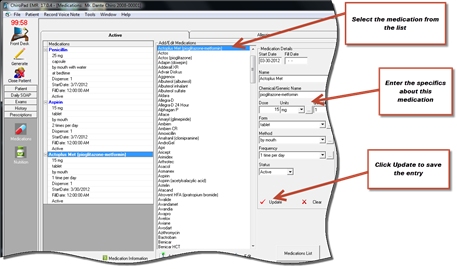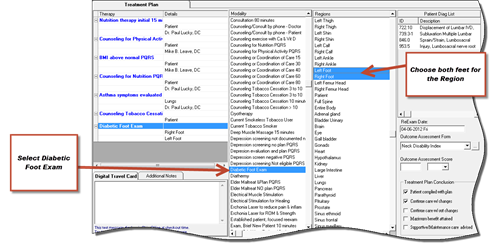
To qualify for this Meaningful Use item, the patient must have a diagnosis of diabetes and be taking diabetes medication. Here is a list of the applicable diabetes diagnoses. Be sure to use only one!
•250.00 Diabetes mellitus without mention of complication, type II or unspecified, not stated as uncontrolled
•250.01 Diabetes mellitus without mention of complication, type I juvenile, not stated as uncontrolled
•250.02 Diabetes mellitus without mention of complication, type II or unspecified, uncontrolled
•250.03 Diabetes mellitus without mention of complication, type I juvenile, uncontrolled
•250.10 Diabetes with ketoacidosis, type II or unspecified, not stated as uncontrolled
•250.11 Diabetes with ketoacidosis, , type I juvenile, not stated as uncontrolled
•250.12 Diabetes with ketoacidosis, type II or unspecified, uncontrolled
•250.13 Diabetes with ketoacidosis, , type I juvenile, uncontrolled
•250.21 Diabetes with hyperosmolarity, type I juvenile, not stated as uncontrolled
•250.22 Diabetes with hyperosmolarity, type II or unspecified, uncontrolled
•250.23 Diabetes with hyperosmolarity, , type I juvenile, uncontrolled
•250.30 Diabetes with other coma, type II or unspecified, not stated as uncontrolled
•250.31 Diabetes with other coma, , type I juvenile, not stated as uncontrolled
•250.32 Diabetes with other coma, type II or unspecified, uncontrolled
•250.33 Diabetes with other coma, , type I juvenile, uncontrolled
•250.40 Diabetes with renal manifestations, type II or unspecified, not stated as uncontrolled
•250.41 Diabetes with renal manifestations, , type I juvenile, not stated as uncontrolled
•250.42 Diabetes with renal manifestations, type II or unspecified, uncontrolled
•250.43 Diabetes with renal manifestations , type I juvenile, uncontrolled
•250.50 Diabetes with ophthalmic manifestations, type II or unspecified, not stated as uncontrolled
•250.51 Diabetes with ophthalmic manifestations, type I juvenile, not stated as uncontrolled
•250.52 Diabetes with ophthalmic manifestations, type II or unspecified, uncontrolled
•250.53 Diabetes with ophthalmic manifestations, type I juvenile, uncontrolled
•250.60 Diabetes with neurological manifestations, type II or unspecified, not stated as uncontrolled
•250.61 Diabetes with neurological manifestations, type I juvenile, not stated as uncontrolled
•250.62 Diabetes with neurological manifestations, type II or unspecified, uncontrolled
•250.63 Diabetes with neurological manifestations, type I juvenile, uncontrolled
•250.70 Diabetes with peripheral circulatory disorders, type II or unspecified, not stated as uncontrolled
•250.71 Diabetes with peripheral circulatory disorders, type I juvenile, not stated as uncontrolled
•250.72 Diabetes with peripheral circulatory disorders, type II or unspecified, uncontrolled
•250.73 Diabetes with peripheral circulatory disorders, type I juvenile, uncontrolled
•250.80 Diabetes with other specified manifestations, type II or unspecified, not stated as uncontrolled
•250.81 Diabetes with other specified manifestations, type I juvenile, not stated as uncontrolled
•250.82 Diabetes with other specified manifestations, type II or unspecified, uncontrolled
•250.83 Diabetes with other specified manifestations, type I juvenile, uncontrolled
•250.90 Diabetes with unspecified manifestations, type II or unspecified, not stated as uncontrolled
•250.91 Diabetes with unspecified manifestations, type I juvenile, not stated as uncontrolled
•250.92 Diabetes with unspecified manifestations, type II or unspecified, uncontrolled
•250.93 Diabetes with unspecified manifestations, type I juvenile, uncontrolled
Enter the diabetes diagnosis on the Diagnosis window.

In the Prescription section, Medications window, the patient must be taking at least one of the following medications:
•Actoplus MET (pioglitazone-metformin)
•Onglyza (saxagliptin)
•Novolin 70/30 (insulin nph & regular human)
•Diabeta (glyburide)

In the Plan window, select the Diabetic Foot Exam.

At least one of the following CPT codes must be used on the date of service when the diabetic foot exam is performed:
Most commonly used codes by
Chiropractors are from 99201 to 99215
|
11042 |
99201 |
99324 |
|
11043 |
99202 |
99325 |
|
11044 |
99203 |
99326 |
|
11055 |
99204 |
99327 |
|
11056 |
99205 |
99328 |
|
11057 |
99212 |
99334 |
|
11719 |
99213 |
99335 |
|
11720 |
99214 |
99336 |
|
11721 |
99215 |
99337 |
|
11730 |
99304 |
99341 |
|
11740 |
99305 |
99342 |
|
97001 |
99306 |
99343 |
|
97002 |
99307 |
99344 |
|
97597 |
99308 |
99345 |
|
97598 |
99309 |
99347 |
|
97802 |
99310 |
99348 |
|
97803 |
|
99349 |
|
|
|
99350 |
There are PQRS codes that apply to the diabetic foot exam:
G8404: Lower extremity neurological exam performed and documented
G8406: Clinician documented that patient was not an eligible candidate for lower extremity neurological exam measure
G8405: Lower extremity neurological exam not performed
G8675: Diabetic foot exam